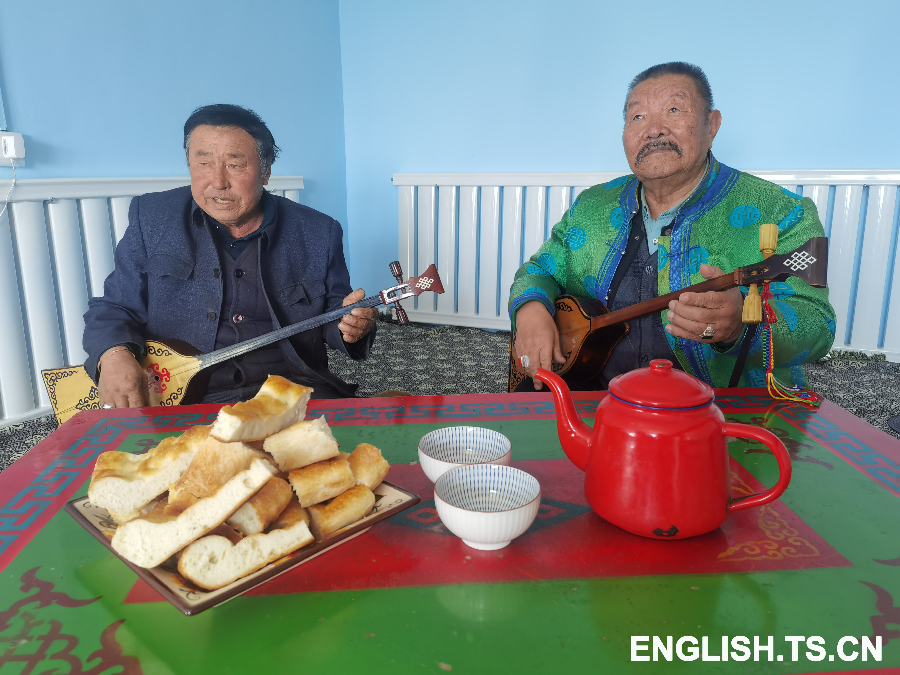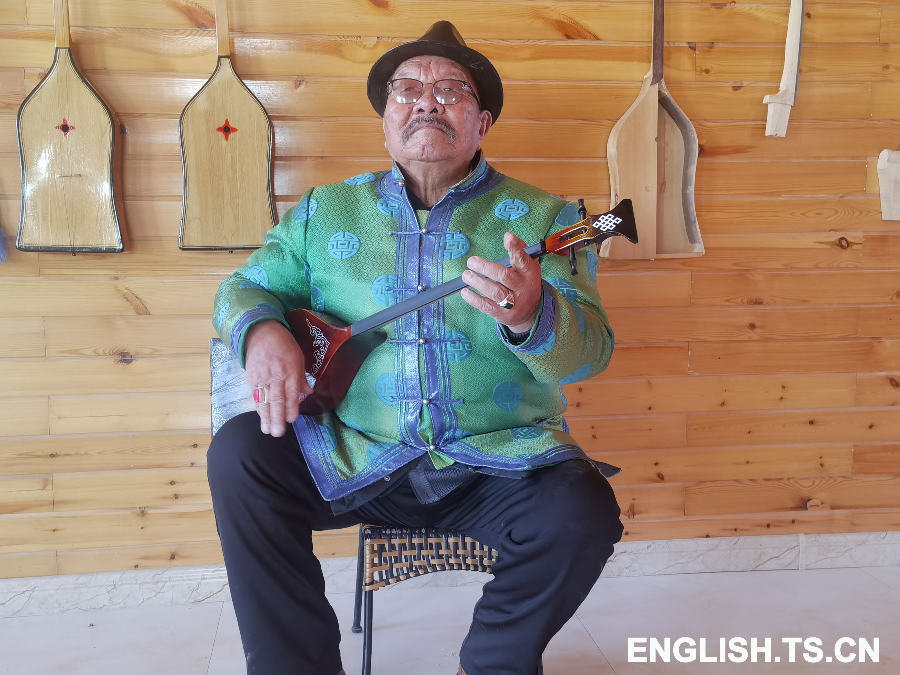Tianshannet-Xinjiang Daily (Reporter Bai Sujun) news: It was winter, and the sun’s radiant rays illuminated the glistening snow. Ma Dega, a 72-year-old, inspected the woodpile in the backyard before going back to the desk, sketching his design on paper. He was trying to make tovshuur using ash wood.
Ma Dega is a prefecture-level tovshuur representative inheritor from Bogdal Village, Zhalemute Township, Wenquan County, Bole City. He is the recipient of more than 60 honorary titles and awards, including the Xinjiang Senior Folk Artist and the Xinjiang Craftsmanship Award.
Tovshuur is a traditional musical instrument among the Mongolian ethnic people in Xinjiang. As integral to his life as eating and sleeping, it serves as an anchor and a source of strength for Ma Dega.
From pleasure to life purpose
“The sound of tovshuur washes away all troubles,” said Ma Dega when picking up the instrument. Young people started dancing to the lively music.
“My father is skilled at playing and making tovshuur. I have been learning from him,” said Ma Dega’s son Ma Ouergeli, noting the ineffable sense of happiness and fulfillment despite the difficulties along the way.

Photo taken on November 20, 2023 shows Ma Dega makes tovshuur at the Bogdal Village of Zhalemute Township in Wenquan County, Bole City, northwest China's Xinjiang Uygur Autonomous Region. (Photo by Shiliuyun-Xinjiang Daily/ Bai Sujun)
According to Ma Dega, his father and grandfather were both carpenters and played tovshuur all their lives, and his mother and grandmother would dance to the rhythm of tovshuur while doing manual labor. What he remembers still now is the music and dance throughout his childhood, as well as fun toys made of offcuts, the envy of his peers at the time.
“My mother sang in a loud, high-pitched voice, and my father was well versed in making tovshuur. People always got together in our courtyard, and we were really happy every day,” recalled Ma Dega. Gradually, he developed a great interest in playing and making tovshuur.
Ma Dega said, “In the past, we only played it for pleasure.” The turning point occurred in 1995 when an old tovshuur artist in the village reminded him to pass down the skills of older generations.
Ma Dega went to the County town to learn musical notation and techniques from Borileda, a well-known local musician. Later, he visited skilled tovshuur makers many times and finally got a grasp of playing and making the musical instrument.
Promoting the best elements of tovshuur
“Don’t underestimate the two strings on the instrument. A one-millimeter difference could lead to totally different timbres. Anyone that knows the work can tell them apart.” Ma Dega introduced that tovshuur has a deep and rich timbre and a strong rhythm, and is easy to carry. “Tovshuur can be played alone or accompany on folk songs and the heroic epic Jangar, for example. As an inheritor, I am proud to promote the best elements of authentic tovshuur,” said Ma Dega with a smile.
As Ma Dega sees it, every tovshuur has life. Having been dealing with tovshuur for over three decades, he has a knack of judging whether a piece of wood is suitable – the older the wood, the deeper the color. To make tovshuur, he will draw a sketch, cut an oval groove the in wood, dig small holes, carve patterns for the neck and the body, make strings with sheep intestines, and then apply the paint and wait for it to dry out. “Tovshuur will have a soul only when it is made with dedication,” stated Ma Dega. When he was younger, he could make four instruments a month, which is something impossible for him at this age. However, when there is high-quality poplar, mulberry, Russian olive, or ash wood, he will still devote himself to making an exquisite instrument.

Photo taken on November 20, 2023 shows Ma Dega and Qingdelike play tovshuur together at the Bogdal Village of Zhalemute Township in Wenquan County, Bole City, northwest China's Xinjiang Uygur Autonomous Region. (Photo by Shiliuyun-Xinjiang Daily/ Bai Sujun)
Qingdelike, one of Ma Dega’s apprentices, has been learning from his master for 11 years. He plays tovshuur when herding sheep, or at family gatherings, weddings or other activities. Where there is tovshuur, there is joyful singing and dancing. “Tovshuur is the star on many occasions. We use it to express our emotions that cannot be described in words. For people living on the grasslands, without tovshuur, it would be like a lamb leaving its mother, and we would lose our way in life,” he stated.
Qingdelike is obsessed with the instrument Ma Dega gave him 10 years ago. “I bring it with me every time I perform. I get along with it on stage, and it accompanies me and gets rid of my troubles off stage. Qingdelike said that every time he sings Jangar while playing tovshuur, he feels like seeing magnificent mountains and vast lakes, and his heart seems to fly as far as the expansive grasslands and as high as the white clouds in the clear blue sky.
Spreading the craft even further
Ma Dega’s passion for and dedication to traditional handicrafts have a deep influence on his son Ma Ouergeli, who shut down his hair salon and started learning to make the instrument in 2014.
He said, “It was hard at first, and a lot of materials were wasted, but after a while, I was doing better and better.” In order to learn how to make tovshuur, he bought a lot of books and went to Ili, Korla, Changji, and other places to find teachers. After acquiring the basic techniques, he went to Inner Mongolia for further study. He noted, “My father’s craftsmanship and techniques are admirable. I want to preserve the craft while injecting new vitality to tovshuur with new knowledge and concepts.”
With the support from the government, Ma Ouergeli built a 1,300-square-meter ethnic musical instrument workshop in 2017. Using modern equipment, the workshop makes tovshuur by combining handicrafts and the assembly line. “The workshop can produce more than 100 instruments a month,” said Ma Ouergeli.
Father and son, together with a group of apprentices, make and repair a variety of musical instruments including tovshuur and matouqin (or horse-head fiddle). On the walls of the workshop is a display of artworks such as matouqin, Mongolian wood carvings, leather paintings, as well as a dozen types of newly made tovshuur, with prices ranging from RMB 800 to RMB 8,000.

Photo taken on November 20, 2023 shows Ma Dega plays tovshuur at the Bogdal Village of Zhalemute Township in Wenquan County, Bole City, northwest China's Xinjiang Uygur Autonomous Region. (Photo by Shiliuyun-Xinjiang Daily/ Bai Sujun)
“Our tovshuur follows the tradition in terms of body, size and patterns, while also featuring innovation in terms of wood and style.” Ma Ouergeli sends the apprentices in batches to Inner Mongolia for training. “There are more varieties of ethnic musical instruments in Inner Mongolia, and they can better hone their skills there,” he added.
“My son is ahead of me when it comes to the techniques and concepts,” acknowledged Ma Dega. Now, he is learning from his son in some way. What they are working on is to bring in new blood to the workshop and engage more people in promoting the traditional craft.









